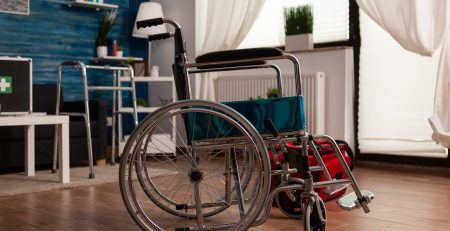- No products in the cart.
Managing your wheelchair: The basics for first-time wheelchair users
Beginning to use a wheelchair can be a scary prospect for anyone, as there are a lot of unknowns for people who are used to ambulating independently (or with less assistance than a wheelchair). While nothing can substitute the advice of a medical professional such as a physical therapist, occupational therapist, or mobility specialist, there are some tips that can help you get acclimated to your new chair and use it safely and productively.
Clothing considerations
You will want to be careful of wearing long, flowing articles of clothing such as fabric belts, scarves, capes, ponchos, etc., as these can easily get stuck in the spokes of your wheelchair and cause a major safety concern. This can cause damage to your wheelchair but, more importantly, it can also cause you harm. You will ideally want to dress in layers. Propelling a manual wheelchair can take a lot of physical effort, especially for someone who is not used to this type of work. The good thing about layers is they can easily be kept handy by sitting on them or storing them in your wheelchair pouch. Similarly, you will want to wear rubber-soled shoes with good arch support. This will be of great help if you need or want to use your feet to help propel your wheelchair (if your footrests have been removed). In these instances, you are also preventing a safety concern that can result from a sandal coming off your foot and getting run over by your wheelchair.
Have the essentials nearby
Wheelchair pouches can certainly come in handy, but you may also want to look into additional accessories to make your wheelchair more useful and convenient. You can get a clip-on cup holder or phone holder for easy storage of something that you need to view often, maybe for navigation purposes or if you’re waiting for a call. This also allows you to have such items readily accessible in case of an emergency. Some individuals may also opt for additional safety features such as brighter night lamps, horns, gloves (to protect their hands and give better grip while propelling), reflective vests (for their bodies), and visors to protect them from the elements while navigating outside.
Other essentials that will help you stay clean and safe while keeping your equipment well-maintained is wet wipes, sanitary wipes, hand sanitizer, and tissues. This will help you avoid any messes while you are out and about while also allowing you to keep your equipment clean in the event of mud, dirt, dog poop, etc. that may impede the function of your wheelchair. Especially nowadays, sanitizing wipes and solutions are ideal to prevent the spread of germs from your hands to your wheelchair and vice versa.
Check the working order consistently
It will be readily apparent to you if something is awry or not working properly. For this reason, staying on top of small bits of maintenance will pay dividends in keeping your wheelchair in as good shape as possible. Ensure your tires always have enough air and know where you can refill them in the community or purchase a hand pump to use at home. If brakes are feeling wiggly as you use them, purchase a small kit with tools to tighten them on your own, or seek assistance for remediating the issue ASAP. Remember, fully-functioning brakes are the cornerstone of a working wheelchair! Without brakes, you will not be able to safely get in and out of your wheelchair, placing yourself at risk for big falls and injuries.
Make adjustments as needed
If you have a caregiver who will be helping you all (or even most) of the time, be sure that they are able to comfortably help operate your wheelchair. This means adjusting the push bars on the back to suit your caregiver’s height. You can purchase lengthened handles to better accommodate them, which also prevents injury and strain on their behalf.
If you find your seat is uncomfortable or doesn’t fit right, seek assistance from a mobility consultant. They will help you make changes (if possible) to the height, width, incline, and depth, if possible. In many cases, they will also recommend that you use a cushion to assist in making it more comfortable (if adjustment is not possible or in your best interest). You can also seek the use of a cushion on your own if you feel an excess of pressure on your rear or simply want more padding.
Adjustments may also refer to the use of armrests and footrests. These features are removable in many wheelchair models for this exact reason — to allow individuals to take part in “customizing” their chair to improve their experience according to their needs. If you have enough core strength to safely and comfortably use your wheelchair without armrests, then this is encouraged. Similarly, if you are someone with active use of the lower body and you want to assist in propelling the wheelchair with your feet, then removing the footplates is likely a good choice for you. There is no one choice that you necessarily need to stick to either. Many models that offer the removal of these features also allow you to take them off and put them back on as needed. For example, individuals who use a slide board to transfer from one surface to their wheelchair need an open side on the wheelchair to successfully complete this transfer. Therefore, many individuals opt to remove the armrest, complete their transfer, and then place the armrest back on for added support and safety.
As you can see, there are many considerations that individuals should be mindful of as they begin to use a new wheelchair. This is a big change that will take some getting used to, but one of the biggest things for individuals to remember is that the wheelchair likely isn’t your only option. In other words, if your legs are still functioning well and you use your wheelchair to assist with a condition such as heart disease, you can switch to using another mobility device (like a walker or a cane) if and when you are feeling strong enough to do so. The wheelchair will still be there for you when you feel your symptoms are increasing and you need more assistance. Just be sure to follow these helpful tips for safe use of your wheelchair when the need does arise.















